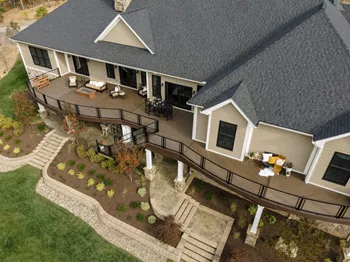Two-Tone Deck Inspiration to Elevate Your Outdoor Space
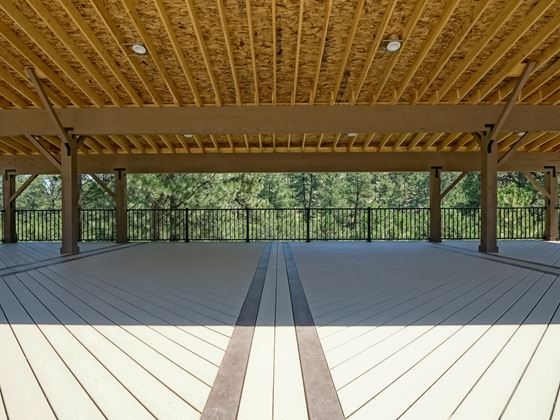
Two-tone decking, which incorporates two different colors of decking to create contrast and visual interest, can almost effortlessly elevate your outdoor living space.
In recent years, two-toned decks have become easier to create due to the wide range of colors available in composite decking. Not only can a two-toned deck stand out among a sea of monochromatic decks throughout the neighborhood, but it can enhance curb appeal and property values – without necessarily increasing your bottom line.
In order to maximize the return on your investment, it’s important to choose a two-tone color scheme for your deck that works for your deck’s size, shape, and budget. In terms of aesthetics, consider decking colors that not only work well together to form the surface of your deck but also complement the color of your home’s facade and trimming, such as shutters and doors.
To help you make the right choice for your home, we’ll share tips for selecting the best two-toned decking, as well as pictures of color schemes to inspire you.
The 3 Essentials for Creating a Stunning Two-Toned Deck
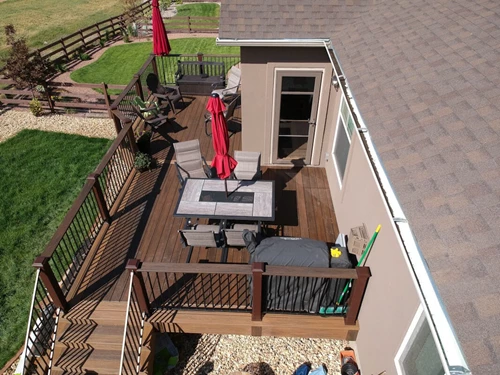
Two-toned decking can be a visually striking addition to your outdoor living space. Although there are a variety of ways to approach two-toned decking in terms of dominant colors, accent colors, and patterns, there are some tried-and-true best practices to keep in mind in terms of aesthetics.
Complement Your House
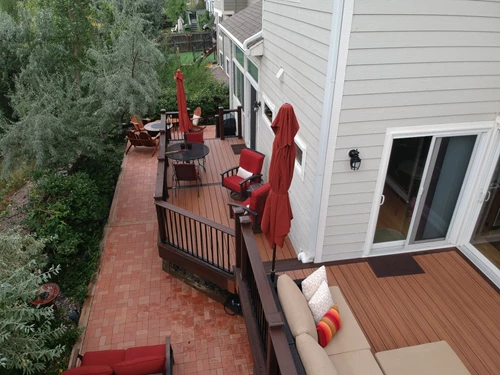
To create a beautiful two-toned deck you'll need to choose a color that complements your home’s exterior. It’s important to consider not only the colors of any shingles, brick, or stucco of your home’s exterior but also the color of any trimmings, such as shutters or doors.
For instance, If your house has a grey undertone, choosing decking within a grey or cool-toned color family can be an attractive option. Similarly, if you have a red-tiled roof or brickwork on your home, red- or brown-toned decking can help play off those features. If this is the case, choosing a lighter tan shade as a secondary color can offer a striking contrast that harmonizes beautifully.
One area of caution, however: Avoid choosing colors that are too close to the actual hue of your house. Otherwise, your deck may blend in with your home’s exterior color and detract from its appearance instead of creating an appealing contrast.
If you have landscaping features, you’ll also want to consider those elements to choose the right colors for a two-tone deck. Is there a beautiful tree in your yard with grey or brown undertones to its bark? Does your outdoor space have a firepit, fireplace, or built-in kitchen? Are there any large rocks or mulch beds in your yard? Keep these features in mind when choosing decking colors.
Modern composite decking comes in a range of colors, often sorted by color families. This can make it easy to select complementary colors that work well together. In many cases, you can order samples to see which shades work best with your home and backyard.
Customize Your Layout and Design
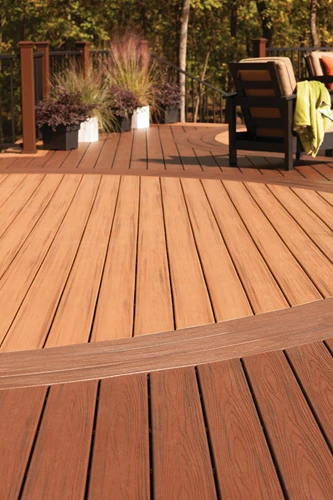
There are many ways to incorporate two-toned decking into your deck layout. For instance, you may have a dominant color that you choose for most of your deck boards, then select an accent color to form a frame around them. From a builder’s perspective, think of this approach as a “picture frame border” built around at least three sides of the deck.
Decide whether you’d prefer your border to be a lighter or darker color than your main deck floor. Choosing a darker color to serve as a border is typically a popular choice, although a lighter-colored border can also look great.
From a construction standpoint, the border board should overhang the fascia of the deck to allow water to properly flow down the face of the fascia instead of running in between the deck boards and the fascia. Since the border overhangs past the fascia, the square edge deck board allows for a clean finished edge to be visible instead of an unfinished edge or a hidden groove becoming an accidental (and unappealing) focal point.
Choosing a different color material for the border of your deck isn't your only option when creating a two-toned deck. You can also use boards in contrasting colors to form a pattern. Many professional decking contractors specialize in installing inlays into decks. An inlay is a design, logo, or pattern laid into the deck floor. This is a beautiful way to incorporate multi-color decking for an eye-catching effect. Another subtle way to accent your deck is to add a secondary color to a mid-deck board to break up a monochromatic deck.
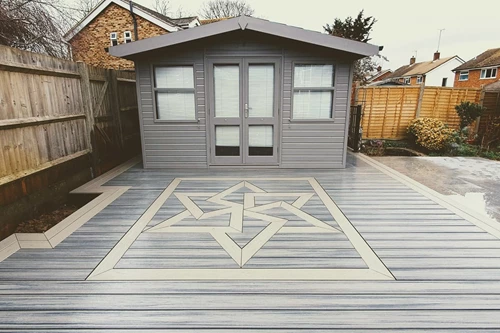
If you’re working with a professional contractor, these builds typically cost more due to the detail involved with blocking and framing, as well as an intricate eye for detail. Whether you’re working with a builder or going the DIY route, you can also use an online deck designer tool to get a better sense of what your chosen colors and patterns will look like together before beginning your project.
Selecting Railings to Complement Your Deck

Choosing railings that work with your two-toned decking is the finishing touch that can make or break your design. In addition to deciding on a material, you’ll also want to consider the style of your railings. Common railing materials include aluminum, wrought iron, PVC, wood and composite. Railing styles span the gamut from classic vertical bar railings to sleek glass railings that offer an unobstructed view of your surroundings from your deck. For a more modern look, cable, rod, and mesh railings have also become popular in recent years.
Most railing options allow for a connection to two different types of posts. The most common posts are aluminum or iron posts. Some railing kits include a post sleeve that covers a 4x4 wood post secured to the deck. For instance, the Trex Transcend® railing line gives homeowners six different colors to choose from, helping to create a bespoke mix-and-match look or a timeless design with go-with-anything neutral hues.
Need more inspiration? Get more images and ideas for incorporating railing into your deck design.
4 Tips for Picking the Best Two-Toned Deck Colors for Your Home
It’s worth the extra effort to carefully select the right colors to complement your home when building a two-toned deck. Modern composite and PVC deck boards now offer a wide range of colors, textures, and finishes that withstand the elements and offer a polished, luxurious look. Additionally, composite decking’s low maintenance requirements make it an aesthetically pleasing option that requires minimal upkeep.
With so many choices available, here are four helpful tips for selecting the right two-toned decking that will set the right “tone” for your home and yard.
1. More Undertones Give You More Options
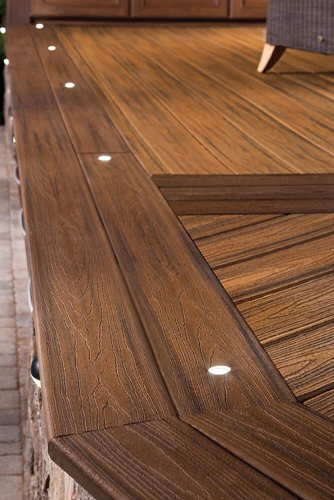
Today’s composite decking stands apart for its wide range of colors, undertones, and textures – often mimicking the look of natural wood with variations in grain and tones. As a result, your decking’s undertones can help you more easily select another color to create a two-toned deck.
Trex has three different deck boards that have streaking and color variation. Trex Transcend® Lineage™ has some blue undertones in the board while Trex Transcend® Tropical and Trex Enhance® Naturals have more black undertones.
These undertones help bring a wide range of deck colors together. The contrasting colored undertones make it easier to find the right secondary color for your deck floor, creating a two-tone composite deck that becomes the envy of the neighborhood.
2. Similar Undertones Create Sophistication and Consistency
When in doubt about choosing colors for your two-toned decking, look to the color wheel to help you choose colors for your two-toned decking! The color wheel arranges related colors more closely together. These are known as “analogous colors,” as they sit right next to each other on the color wheel.
To illustrate, consider the following deck, which integrates two distinct tones of brown. Trex's Havana Gold shade of decking represents the lighter hue with its inviting warm yellow-orange undertones. It elegantly complements the deeper reddish-orange tint present in the darker deck boards, specifically Trex's Spiced Rum. This strategic pairing creates an engaging visual contrast while maintaining an overall cohesive appearance.
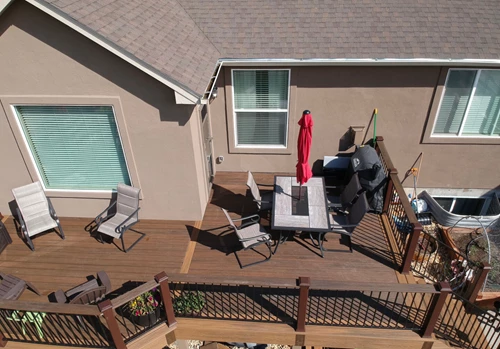
3. Complementary Undertones Create Eye-Catching Contrast
Exploring the color wheel also opens up the option of seeking complementary colors. This approach introduces a more pronounced contrast, all while ensuring that even the most distinct shades coexist harmoniously, rather than clash. While analogous colors are positioned next to each other, the color wheel also positions contrasting colors opposite one another.
A great example of this principle involves the use of blue and orange. These colors are positioned directly opposite each other on the color wheel. Despite their stark dissimilarity, they maintain a harmonious balance.
For an example of contrasting undertones, take a closer look at the deck boards showcased below. One variant, Trex Select's Saddle shade, has a brownish-orange hue. On the flipside, Trex Select's Pebble Grey, has a grayish-blue tone.
Using analogous colors produces a more subtle effect. However, if you intend to create a sharp contrast that truly captivates attention—such as delineating the edges of your deck with a race-track design or creating a pattern with your deck boards to accentuate pathways or distinctive zones within your deck—contrasting deck boards are the way to go!
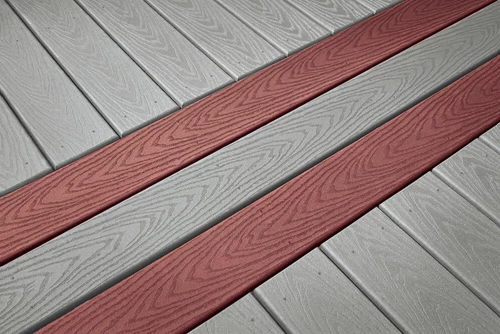
4. Be Bold in the Decision to Select a Two-Tone Deck
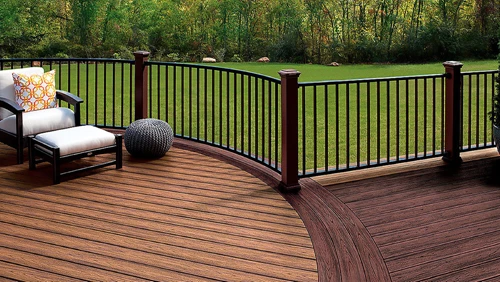
Embracing a daring approach to deck design involves skillfully harmonizing two distinct colors to create an aesthetically captivating outdoor space. Two-tone deck color schemes have gained in popularity, allowing homeowners to infuse their personality and style into their outdoor living area.
By selecting two hues that work well together – either for a tonal effect or a sharper contrast – homeowners can create a beautiful deck that elevates their space and shows the world (or at least the neighborhood) their own sense of style.
The key to successfully designing a two-color deck lies in careful selection. For example, one color might dominate the main deck area, while the other is used as an accent or border. This approach can add depth and dimension to the space, making it feel more dynamic and inviting. From warm earthy tones to contrasting cool shades, the possibilities are limitless, offering a creative outlet for homeowners to tailor their decks to their unique preferences.
Two-tone decking can transform an ordinary outdoor space into a captivating haven that reflects personal style and design sensibilities. When executed thoughtfully, this approach can turn a simple deck into an artistic expression. The concept of a two-color deck encourages experimentation, allowing individuals to play with color psychology and visual effects. For instance, lighter tones can make a space feel more open and airy, while darker shades can lend a sense of intimacy and coziness. The strategic placement of the second color – whether it's on railings, borders, or steps – can create focal points and guide the eye throughout the space.
The Most Popular and Beautiful Two-Toned Deck Colors
In the realm of deck design, embracing a two-color palette opens the door to endless opportunities for self-expression and curating a truly unique outdoor retreat. Whether your style is trendy or timeless, two-toned decking can set your deck apart, enhancing curb appeal and your enjoyment in a beautiful space.
As a professional deck builder and Trex Pro Platinum Contractor, I have seen every color combination imaginable. While all of my choices are going to be in the Trex Family, every other composite manufacturer will have similar color choices to these. Here are some of my favorite decking color combinations that you can look to for your inspiration:
Tiki Torch with Spiced Rum Border
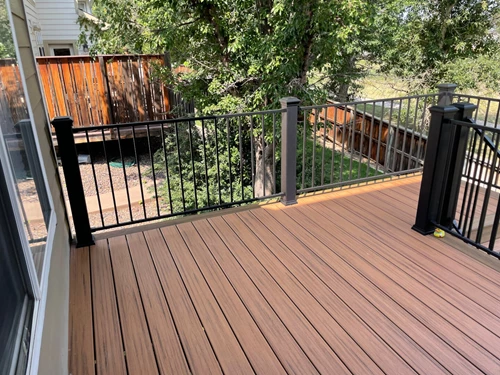
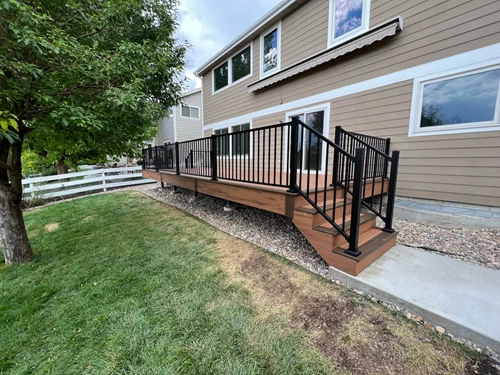
Spiced Rum with Havana Gold Border

Tiki Torch Decking with Lava Rock

Rope Swing Decking with Vintage Lantern Border
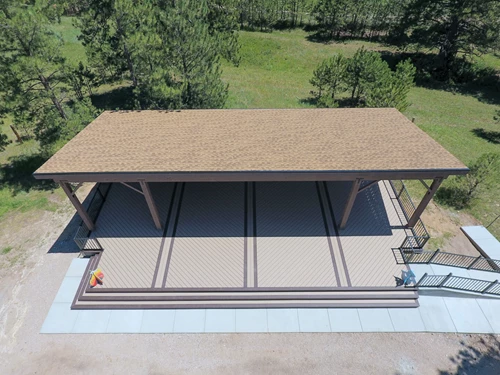
Biscayne Decking with Spiced Rum Border
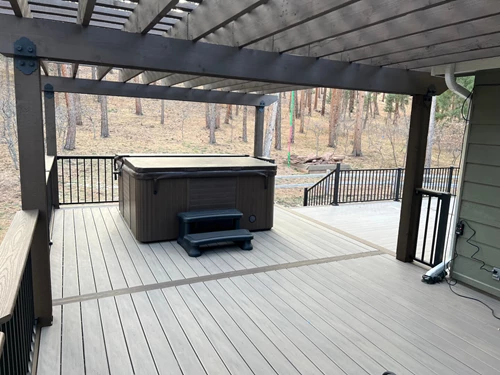
Island Mist with Vintage Lantern Border
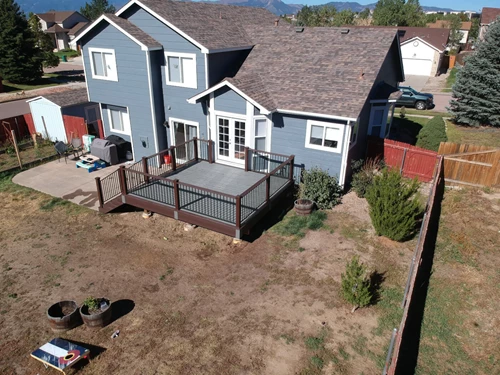
Find Even More Inspiration for Your Dream Outdoor Deck Space


